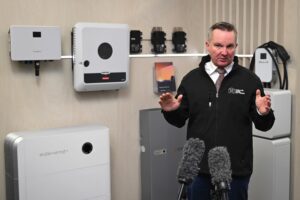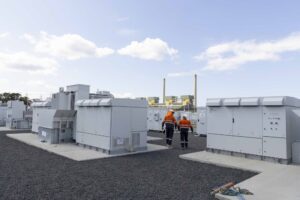Western Australia has come out of the blocks with a strategy to manage the state’s booming rooftop solar market that includes extending grid export payments to home batteries and electric vehicles, and encouraging new solar systems to be installed facing the west.
The Distributed Energy Buyback Scheme, or DEBS, was launched on Monday and will kick in on Friday, November 6 for all households, schools and not-for-profits that – as of this week – install new solar systems up to 5kW in size, upgrade their existing PV system (again up to 5kW), or add a battery.
At the core of the plan is a time-varying solar feed-in tariff – or buyback rate, as it is termed in W.A. – that aims to incentivise households to use or store their rooftop solar generation (using a home battery or the EV battery) in the mornings and the middle of the day and export any excess during the late-afternoon, early-evening peak.
The Buyback Scheme will offer 10 cents a kilowatt-hour for electricity exported between 3pm and 9pm, and just 3c/kWh for electricity exported at all other times. This compares to the existing Renewable Energy Buyback Scheme (REBS) flat rate of 7c/kWh.
The idea is that this will help to even out the “solar duck curve” that is causing state governments and the Australian Energy Market Operator to sweat about overall grid stability, while also supporting the uptake of technologies considered essential to the transition to net-zero emissions – battery storage and electric vehicles.
“Western Australia is undergoing a massive energy transformation, with one in two households expected to have solar panels by 2030,” said state energy minister Bill Johnston in comments on Monday.
“This new scheme encourages households to make the most of their solar energy, when it is plentiful in the middle of the day, which not only benefits them but also supports the grid.
“It encourages households to install batteries and west-facing panels, which helps stretch solar generation into the afternoon-evening peak, extending the time to benefit from the sun’s rays.”
Western Australia is not alone in searching for ways to manage a booming rooftop solar resource so that it benefits the greater grid, rather than impedes it.
It has been an increasing preoccupation of AEMO, which just last week stressed the urgent need for new powers to “switch off” rooftop solar, due to the system risks it poses on multiple levels, including minimum demand, voltage management and system strength issues. And South Australia is in the midst of its own scramble to put in place new solar standards and protocols.
Western Australia, meanwhile, finds itself at the bleeding edge of possible solutions by virtue of the state’s huge uptake of rooftop solar and its unique position outside of the National Electricity Market. Over the weekend, it appeared that the state set a new record low for minimum demand (the demand not supplied by rooftop solar) of 1,059MW.
“We have a challenge that no one else does,” Johnston said in April, at the launch of the state’s Distributed Energy Roadmap, the first of three key documents that will map out a pathway to a zero emissions grid and the end of fossil fuel generation.
“We have a high take up of distributed energy resources and an islanded grid. We can’t rely on other states to support our activity.”
But as Johnston has since noted, these same challenges can also be seen as advantages, in that Western Australia’s position outside of the NEM means “we just make out own decisions and get on with it.”
“We have to be 100 per cent self-reliant and we don’t have the ability to interconnect with anybody else, so that means we have to solve our own problems,” Johnston told a webinar in May. “But at least we’re allowed to solve our own problems.”
And that is what the state is getting on and doing – or at least, attempting to do – with the introduction of DEBS.
Johnston says DEBS will only apply to eligible households, schools and not-for-profits installing new solar panels or batteries, or upgrading their existing solar panel system (up to a five kilowatt maximum).
Existing solar customers will continue to receive the aforementioned REBs, unless they upgrade their PV system, add a battery or elect to switch to DEBS – in which case they may need to pay for a meter change.
“This strategy aims to better integrate new technologies, enabling a greener grid for the benefit of all Western Australians and avoids the risk of needing to limit new solar installations,” the DEBS information sheet says.
“With DEBS, the new pricing structure encourages households to either use or store their solar energy generation in the middle of the day when it is plentiful and to install west-facing panels that will generate electricity later in the day i.e. producing more renewable energy when it is in high demand.
“DEBS also recognises the growing role of household storage in our electricity system.”
The push to have future rooftop solar systems installed with their panels facing west is an interesting feature of the scheme. It follows the release of a University of South Australia study earlier this month that suggested the nation-wide habit of facing rooftop systems to the north was short-changing consumers and adding to the “duck-curve” shaped problems of Australia’s increasingly solar saturated grids.
Whether DEBS will work to change consumer patterns of energy use, or offer incentive enough to convince them to invest in battery storage or an electric vehicle, remains to be seen.
A similar time-of-use solar tariff has gained little traction in Victoria since its introduction in 2017, although that could come down to the fact that it is optional for retailers to offer it. According to the state’s Essential Services Commission, in February of this year, EnergyAustralia was the only company to offer both a single rate FiT and a time-varying FiT rate to its customers.
In Western Australia, there will be no such option – not for new solar customers, in any case. So the rest of Australia will likely be watching closely to see how customers respond.
Ian Porter, the chair of Sustainable Energy Now, said he supported the changes.
“SEN has advocated changing tariffs to encourage the take up of batteries by roof top solar owners to address the duck curve,” he said in a statement.
“The new tariff structure will result in consumer behaviour appropriately adjusting thus making the grid more resilient and efficient. SEN encourages the government to go further and plan for the exit of coal and gas fired generation so that the transition to renewables, particularly the introduction of more wind generation, can proceed smoothly.”








